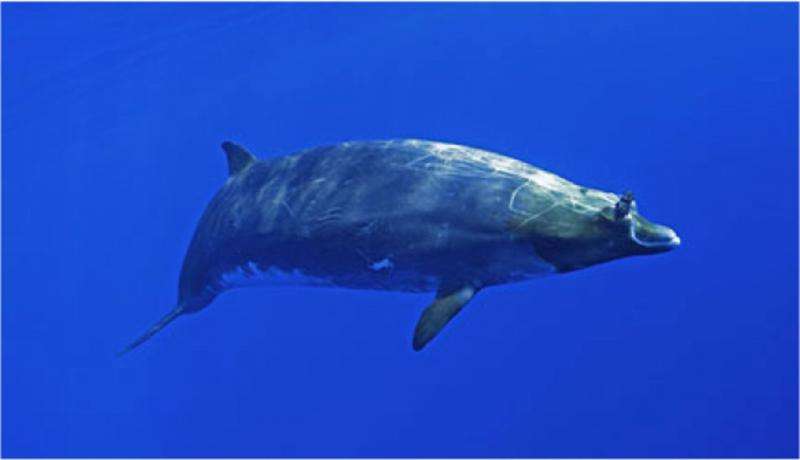Beaked whales B-stroke for long dives

Foraging animals tread a narrow metabolic tightrope, rationing the energy they expend in the pursuit of food to make the most of a catch. And marine mammals that dive on a single breath of air have to be even more frugal to eke out their meagre oxygen stores. Lucía Martín López and colleagues from the University of St Andrews, UK, and the University of La Laguna, Spain, explain that bigger diving mammals should be able to dive and forage for longer than more diminutive species with the same foraging style, as larger divers should be able to carry more oxygen on board: but the data didn't hold up. '25,000 kg sperm whales and 1000 kg beaked whales perform dives of comparable duration (30–50 min) and depth (600–1200 m),' says Martín López. Intrigued by the beaked whales' powers of endurance, Martín López and her colleagues, Mark Johnson, Patrick Miller and Natacha Aguilar de Soto, realised that they needed to know more about the diving styles of beaked whales – ranging in size from Blainville's beaked whales to Cuvier's beaked whales and northern bottlenose whales – to find out more about the impressive duration of their dives.
Tagging whales off the Canary Islands, Italy and Canada over a period of 8 years, the team and a group of helpful volunteers collected 3D acceleration traces as the animals dived, in addition to recording their orientation in the earth's magnetic field, to learn more about the rotation and acceleration of their bodies as they swam. Recording almost 100 deep foraging dives – lasting on average between 49 and 59 min and plumbing depths of 844–1572 m – the team saw the whales continually beating their tails during the initial descent, before switching to prolonged glides. And during the whales' return to the surface, they often beat their tails continually. However, the team noticed a new style of tail beat interspersed between periods of the more conventional swimming style while they returned: a high acceleration tail beat produced by a faster and wider sweep of the tail followed by a brief glide. Dubbing the novel strokes 'B-strokes', because they are bigger (in amplitude and speed), the team realised that the ascending animals relied heavily on the powerful strokes during the early stages of the ascent, with B-strokes contributing 50% of the tail beats during the ascents of Cuvier's beaked whales.
Puzzled why the whales favoured this burst and glide technique over continual swimming during ascents, the team calculated the average speed over a B-stroke cycle, including the 3–5 s long glide, and discovered that even though the animals accelerated to 1.7 m s−1 during a B-stroke, the average speed over the entire cycle was similar to the speed achieved by animals that swam continually (1.3 m s−1). The researchers suspect that the whales may be taking advantage of powerful Type II anaerobically fuelled muscle fibres, which surprisingly comprise 80% of their swimming muscles, to drive them on as their oxygen supplies dwindle toward the end of a dive. 'Similar fast-twitch recruitment when muscles are fatigued has been observed in exercising humans', they say. And the team adds that the short glides that follow each powerful burst could reduce the drag experienced by the animals to keep their costs down.
More information: Martín López, L. M., Miller, P., Aguilar de Soto, N. and and Johnson, M. (2015)." Gait switches in deep-diving beaked whales: biomechanical strategies for long-duration dives." J. Exp. Biol. 218, 1325-1338 DOI: 10.1242/jeb.106013
Provided by The Company of Biologists

















